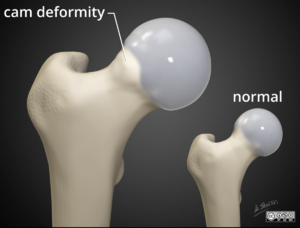Maximal Squat Test: Difference between revisions
No edit summary |
No edit summary |
||
| Line 3: | Line 3: | ||
== Purpose == | == Purpose == | ||
[[File:FAI Cam deformity.png|thumb|FAI Cam deformity]] | [[File:FAI Cam deformity.png|thumb|FAI Cam deformity]] | ||
The maximal squat test is used for screening for [[Femoroacetabular Impingement|Femoroacetabular impingement]] (FAI). | The maximal squat test is used for screening for [[Femoroacetabular Impingement|Femoroacetabular impingement]] (FAI). FAI is a cause of [[hip]] pain in young adults. It is caused by abnormal morphology in the head of the [[femur]] (CAM) or the acetabulum (PINCER). That leads to abnormal contact between the acetabular rim and the head of the femur resulting in repetitive microtrauma to the hip.<ref name=":0">Ayeni O, Chu R, Hetaimish B, Nur L, Simunovic N, Farrokhyar F, Bedi A, Bhandari M. A painful squat test provides limited diagnostic utility in CAM-type femoroacetabular impingement. Knee Surgery, Sports Traumatology, Arthroscopy. 2014 Apr;22(4):806-11.</ref> | ||
Maximal or deep hip flexion during a [[Squat Exercise|squat]], places the hip joint under load and can initiate the engagement of the CAM type femoral deformity into the acetabular socket.<ref name=":0" /> It is easily administered. | |||
== Technique == | == Technique == | ||
[[File:Squat Technique.jpeg|thumb|alt=|200x200px|Squat Technique]] | [[File:Squat Technique.jpeg|thumb|alt=|200x200px|Squat Technique]] | ||
The patient stands with their legs shoulder apart and perform a deep squat reaching as low as possible. | The patient stands with their legs shoulder apart, and their arms are lifted up in front of their body to shoulder height in order to enable balance. The patient is instructed to perform a deep squat reaching as low as possible.<ref name=":0" /><ref>Ayeni O, Chu R, Hetaimish B, Nur L, Simunovic N, Farrokhyar F, Bedi A, Bhandari M. [https://www.researchgate.net/publication/257073973_A_painful_squat_test_provides_limited_diagnostic_utility_in_CAM-type_femoroacetabular_impingement A painful squat test provides limited diagnostic utility in CAM-type femoroacetabular impingement.] Knee Surgery, Sports Traumatology, Arthroscopy. 2014 Apr;22(4):806-11.</ref> | ||
The test is positive if the maximal squat recreated the patient’s typical hip and groin pain.<ref name=":0" /> | * The test is positive if the maximal squat recreated the patient’s typical hip and groin pain.<ref name=":0" /> | ||
* A negative test resulted in no pain from the maximal squat. | |||
== Evidence == | == Evidence == | ||
Latest revision as of 16:23, 14 November 2022
Purpose[edit | edit source]
The maximal squat test is used for screening for Femoroacetabular impingement (FAI). FAI is a cause of hip pain in young adults. It is caused by abnormal morphology in the head of the femur (CAM) or the acetabulum (PINCER). That leads to abnormal contact between the acetabular rim and the head of the femur resulting in repetitive microtrauma to the hip.[1]
Maximal or deep hip flexion during a squat, places the hip joint under load and can initiate the engagement of the CAM type femoral deformity into the acetabular socket.[1] It is easily administered.
Technique[edit | edit source]
The patient stands with their legs shoulder apart, and their arms are lifted up in front of their body to shoulder height in order to enable balance. The patient is instructed to perform a deep squat reaching as low as possible.[1][2]
- The test is positive if the maximal squat recreated the patient’s typical hip and groin pain.[1]
- A negative test resulted in no pain from the maximal squat.
Evidence[edit | edit source]
The maximal squat test was found to have slight positive diagnostic ability for CAM-type FAI. The sensitivity and specificity of the maximal squat test were 75 % and 41 %, respectively, for CAM-type FAI deformity. The positive and negative likelihood ratios were modest at 1.3 and 0.6, respectively.[1]
References[edit | edit source]
- ↑ 1.0 1.1 1.2 1.3 1.4 Ayeni O, Chu R, Hetaimish B, Nur L, Simunovic N, Farrokhyar F, Bedi A, Bhandari M. A painful squat test provides limited diagnostic utility in CAM-type femoroacetabular impingement. Knee Surgery, Sports Traumatology, Arthroscopy. 2014 Apr;22(4):806-11.
- ↑ Ayeni O, Chu R, Hetaimish B, Nur L, Simunovic N, Farrokhyar F, Bedi A, Bhandari M. A painful squat test provides limited diagnostic utility in CAM-type femoroacetabular impingement. Knee Surgery, Sports Traumatology, Arthroscopy. 2014 Apr;22(4):806-11.








